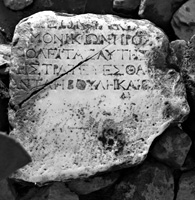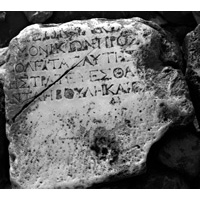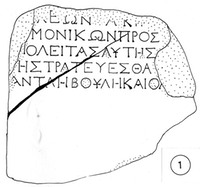 MAMA XI 25 (Eumeneia)
MAMA XI 25 (Eumeneia) 
Honorific statue-base
- Type of monument:
- Honorific statue-base.
- Location:
- Kavak (Eumeneia): in a well-head.
- Description:
- White marble block, broken above, below, right and behind, later re-used as the winch-stone of a press.
- Dimensions:
- Ht. 0.58+; W. 0.64+; Th. 0.61+; letters 0.035.
- Record:
- Line drawing; MB notebook copy; photograph (1956/59a).
- Publication:
- None.
- Date:
- c. AD 169-172 (see commentary)
[- - - - - - - - - - - - - - - - - - - -]
[. .]Λ̣ΕΩΝ . Λ̣ . Κ̣ . [- - - - - - - - ἡγ]-
[ε]μονικῶν προσ[- - - - - - - - - -]
π̣ολείτας αὐτῆς [- - - - - - - - - -]
Η στρατεύεσθα[ι - - - - (e.g.) πείσ]-
5αντα ἡ βουλὴ καὶ ὁ δ[ῆμος vac. ?]
vac.
...official Roman... its citizens... to serve in the army... having (persuaded?)... the council and the p[eople] (honoured him).






This monument is a fragment of an honorific statue-base, which appears on the basis of its letter-forms to date to the second or early third century AD. The village of Kavak is situated in the Maeander plain some 25km south-west of Işıklı. Only one inscription from the village has been published hitherto, a statue-base of the emperor Antoninus Pius, set up during the first year of the new emperor’s reign by a certain Apollodotos, who also minted coinage to mark the occasion (Ramsay, Phrygia I 246, no. 86, with Leschhorn 1993: 282-7; Thonemann 2011a: 121-2). Significantly, this coinage was minted in the name not of Eumeneia, but of the Hyrgaleis (von Aulock 1980: nos. 329–30, 358–61; RPC IV (http://rpc.ashmus.ox.ac.uk) nos. 1822, 1824). This strongly suggests that the village of Kavak should be attributed to the region known in antiquity as the Hyrgaleitikon pedion, the Hyrgaleian plain. Three other inscriptions are known from the vicinity of Kavak, all of which ought probably also to be attributed to the Hyrgaleis: (1) MAMA IV 327, from a site 3 miles west of Kavak; (2) SEG 55, 1413, from Sarıbeyli höyük, some 2 miles NE of Kavak; (3) Hamilton 1842: II 468, no. 348 (CIG 3902 u), apparently from the region around Kavak (Hamilton 1842: II 163-4). It is conceivable that the letters Λ̣ΕΩΝ in line 1 of our inscription ought to be restored as the end of the ethnic [Ὑργα]λ̣έων.
I understand the sequence ΜΟΝΙΚΩΝ in line 2 to be the end of the adjective ἡγεμονικός, ‘official/gubernatorial’, as in e.g. IAph2007 12.1107 and 13.151 (ἐντεύξεως ἡγεμονικῆς, ‘Roman official intervention’); MAMA I 170 (Laodikeia Katakekaumene: στρατευσάμενος ἐν τῇ κατὰ Πισιδίαν ἡγεμονικῇ τάξι). The sequence ΑΝΤΑ in line 5 is presumably the end of an aorist participle, describing one of the actions for which the honorand was recognised by a boule and demos (perhaps those of the Hyrgaleis). I assume that the genitive αὐτῆς in line 3 refers to the polis concerned.
The inscription is non-formulaic and cannot be restored with any certainty; the line-length is unclear. However, the verb στρατεύεσθαι in line 4 may suggest one specific historical context. During the Marcomannic wars, and specifically in the period AD 169-172, Marcus Aurelius recruited several members of the local militias of the cities of the eastern Roman provinces into the Roman army (SHA Hadrian 21.6-9, with Nollé 1995: 365-6). This mass levy is relatively widely attested, at Thespiai in Boiotia (Jones 1971), Termessos in Pisidia (TAM III 1, 106), and Aizanoi in northern Phrygia (IGR IV 580; MAMA IX P 50). It has recently been suggested that another inscription, from Teos in Ionia (IGR IV 1572), should also be connected with this mass recruitment (Mitchell 1994: 145-7). In the inscription from Teos, the anonymous benefactor is honoured in the following words: εἴς τε τὴν τοῦ Σεβαστοῦ ἐπιταγὴν πείσαντα διὰ τῆς ἑαυτοῦ μεγαλοφροσύνης πολείτας αὐτομόλους στρατεύσασθαι, ‘in response to the emperor’s command, through his generosity of spirit he persuaded citizens to volunteer to serve in the army’. It is tempting to assume that a similar situation lies behind the new inscription from Eumeneia: in response to an official Roman request for men ([ἡγε]μονικῶν, lines 1-2; perhaps [ἐξ ἡγε]μονικῶν προσ[ταγμάτων] or προσ[τάξεων], ‘on gubernatorial orders’), the honorand has persuaded (e.g. [πείσ]αντα, lines 4-5) a group of citizens of Eumeneia (π̣ολείτας αὐτῆς, line 3) to volunteer for temporary service in the Roman army (στρατεύεσθα[ι], line 4). In this case, the monument would date to the period AD 169-172 or shortly afterwards.